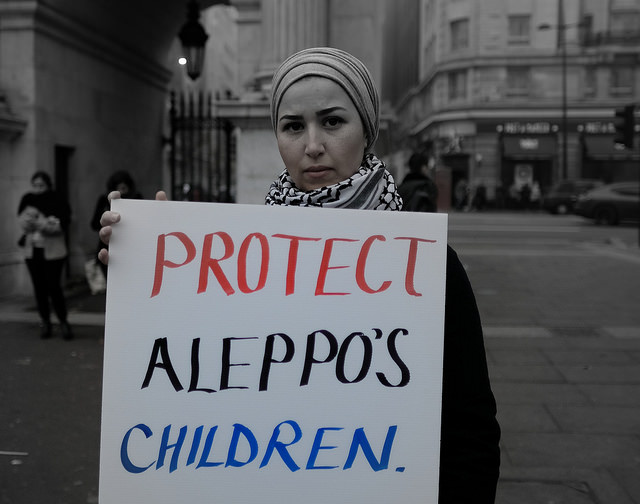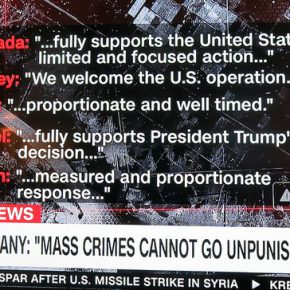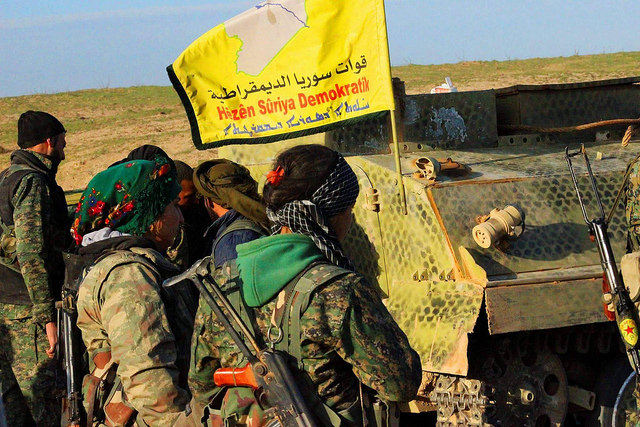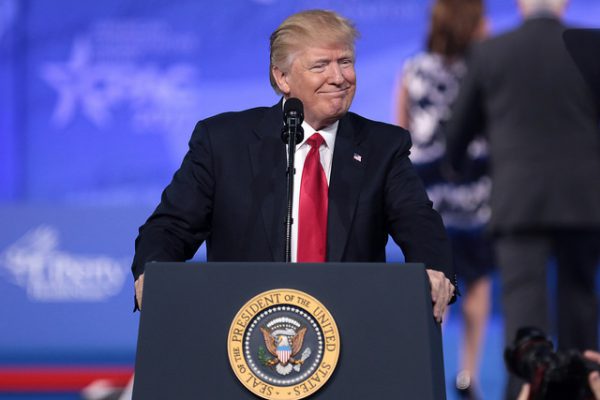The White House has drawn another “red line” in Syria, saying regime barrel bombs carrying industrial chemicals such as chlorine may prompt a U.S. response. Syria Deeply spoke to Andrew Tabler of the Washington Institute for Near East Policy about the new U.S. position.
AFTER WHITE HOUSE press secretary Sean Spicer said the use of barrel bombs by the Syrian government was another “red line,” the White House rowed back somewhat, saying that Spicer was referring to barrel bombs carrying industrial chemicals such as chlorine.
Yet if the U.S. adheres to even that narrower red line, it could significantly increase U.S. military action in Syria. Chlorine gas is the “most common” substance being used in chemical attacks since 2013, as Ole Solvang, deputy director for emergencies at Human Rights Watch, told Syria Deeply. Chlorine, which is a common cleaning agent, is easily produced and can be weaponized in concentrated quantities but is not banned under the Chemical Weapons Convention.
Syria Deeply spoke with Andrew Tabler of the Washington Institute for Near East Policy about the possible implications of the new U.S. position on the kinds of weapons being used by the Syrian government, as well as the mounting pressure on Russia to withdraw support for Assad.
Syria Deeply: What would it take for the U.S. to enforce the red line under the wider criteria?
Andrew Tabler: They have subsequently confirmed that if [the Assad regime] uses chlorine or industrial chemicals using barrel bombs, then you would have a situation where such a red line would be enforced. With that clarification, that tells you where they’re drawing the red line. Assad has violated the chemical weapons convention so many times. It’s a matter of not wanting to slaughter people in Syria and it’s a larger issue of the nonproliferation regime. I think these two things together are the reason why they drew the red line where they did.
Syria Deeply: What are the implications for the war in Syria?
Tabler: Previously, the Assad regime obviously thought they could use chlorine in barrel bombs on their own people. I think now, with that drawing of the red line, if they decide to use this strategic weapon again, the regime stands a strong chance of being punished, probably through a missile strike, bombing combat aircraft or other kinds of attacks. I think that’s primarily what you’d be looking at. I don’t think you’d be looking at boots on the ground, other than the special operations forces. I think the fight against ISIS will continue to be the main thrust of the American approach in Syria. We have to wait and see what kind of measure they use to enforce the red line.
Syria Deeply: Foreign ministers from G7 nations meeting in Italy have pressured Moscow to part ways with its ally, Bashar al-Assad. What outcome do they hoping for in making Russia choose between the U.S. and Assad?
Tabler: They wanted a negotiated settlement to the crisis, in which Assad leaves the country and some sort of transitional government is left in place. In that way, that policy hasn’t changed. How you get there and what the mechanism for it is – that is open to question, as well as the timing of when Assad would exit. I think that’s primarily what they’re going to talk to the Russians about. I doubt that the Russians will accept it. I think they will continue to say that Assad should stay. And I don’t expect them to cut their ties with the Assad regime and their support anytime soon. But I do think that over time this might affect their calculations if they think that the Assad regime continues to rely on chemical weapons to try and win this war.
Syria Deeply: U.S. president Donald Trump and U.K. prime minister Theresa May agreed in a phone call on Monday that a “window of opportunity now exists in which to persuade Russia that its alliance with Assad is no longer in its strategic interest,” according to a spokeswoman for May’s office. How did they get to that conclusion? What is in Russia’s strategic interest instead?
Tabler: Because Russia has tied itself to a regime that does not have the manpower to win the war, and would need to put in more and more support for Assad in order for him to continue. I think they’re going to try to convince Russia to leave that path and go on a different one. And this is part of a long-term strategy to get some space between the Russians and Iranians and get them going in different directions.
Syria Deeply: Russia has in theory been in Syria for the bases in Latakia, which Putin has now secured. Can the U.S.convince Russia to sacrifice that, and how? Will the Americans somehow compensate the Russians?
Tabler: There’s a difference between leaving the sovereign base at Hmeimem and reducing their presence or withdrawing support. They can keep their base there and lessen their support for Assad. I think these two things are not incompatible.
Syria Deeply: How much of this U.S. decision to go against Assad has to do with maintaining or strengthening relations with Saudi Arabia?
Tabler: I think it does have something to do with that. It’s a result of some of the bilateral talks that have been going on recently between the White House and the Saudi monarchy. This, however, is part of the general idea of getting some of the Sunni countries back on line and back in the American orbit. They see this as an opportunity to do that.
This article originally appeared on Syria Deeply, and you can find the original here. For important news about the war in Syria, you can sign up to the Syria Deeply email list.
Photograph courtesy of Alisdare Hickson. Published under a Creative Commons license.





